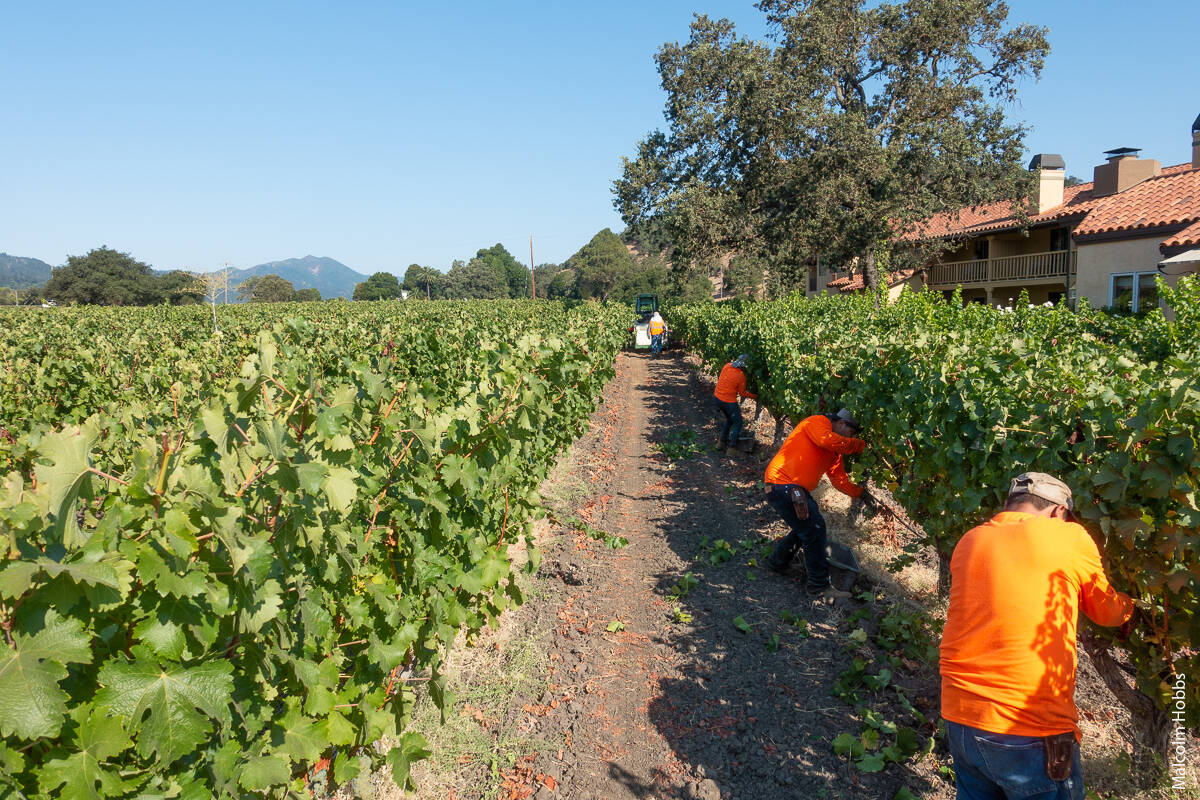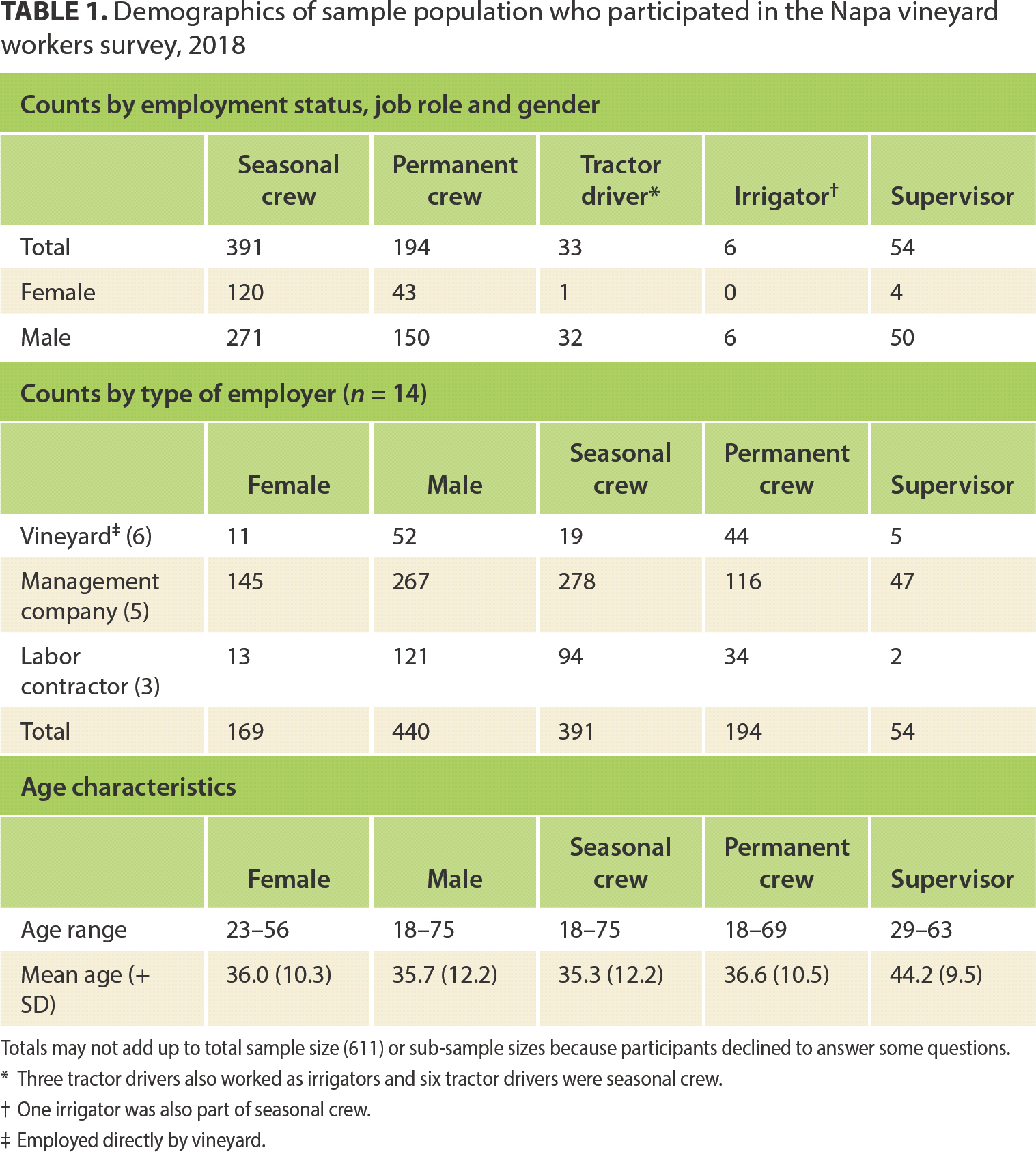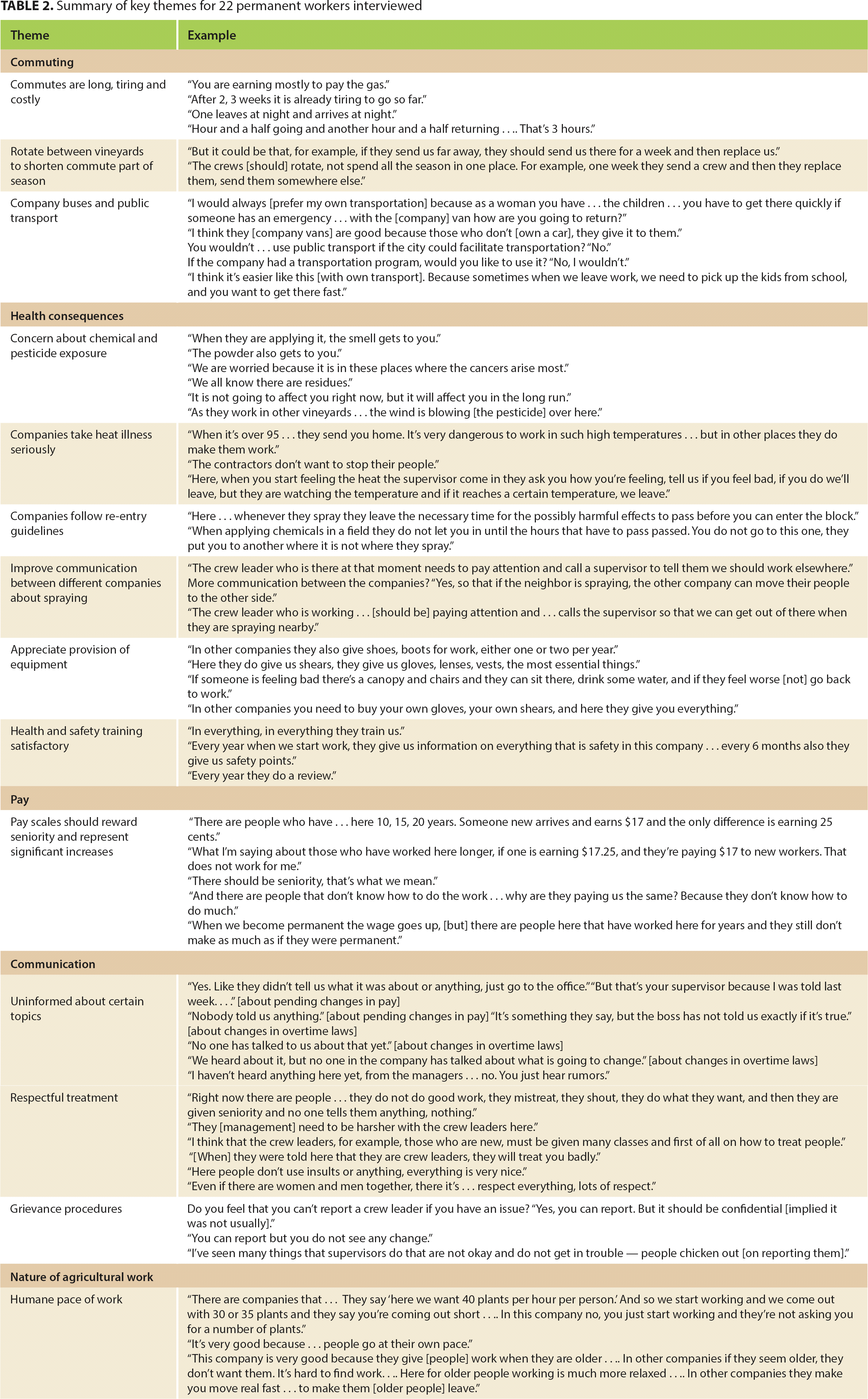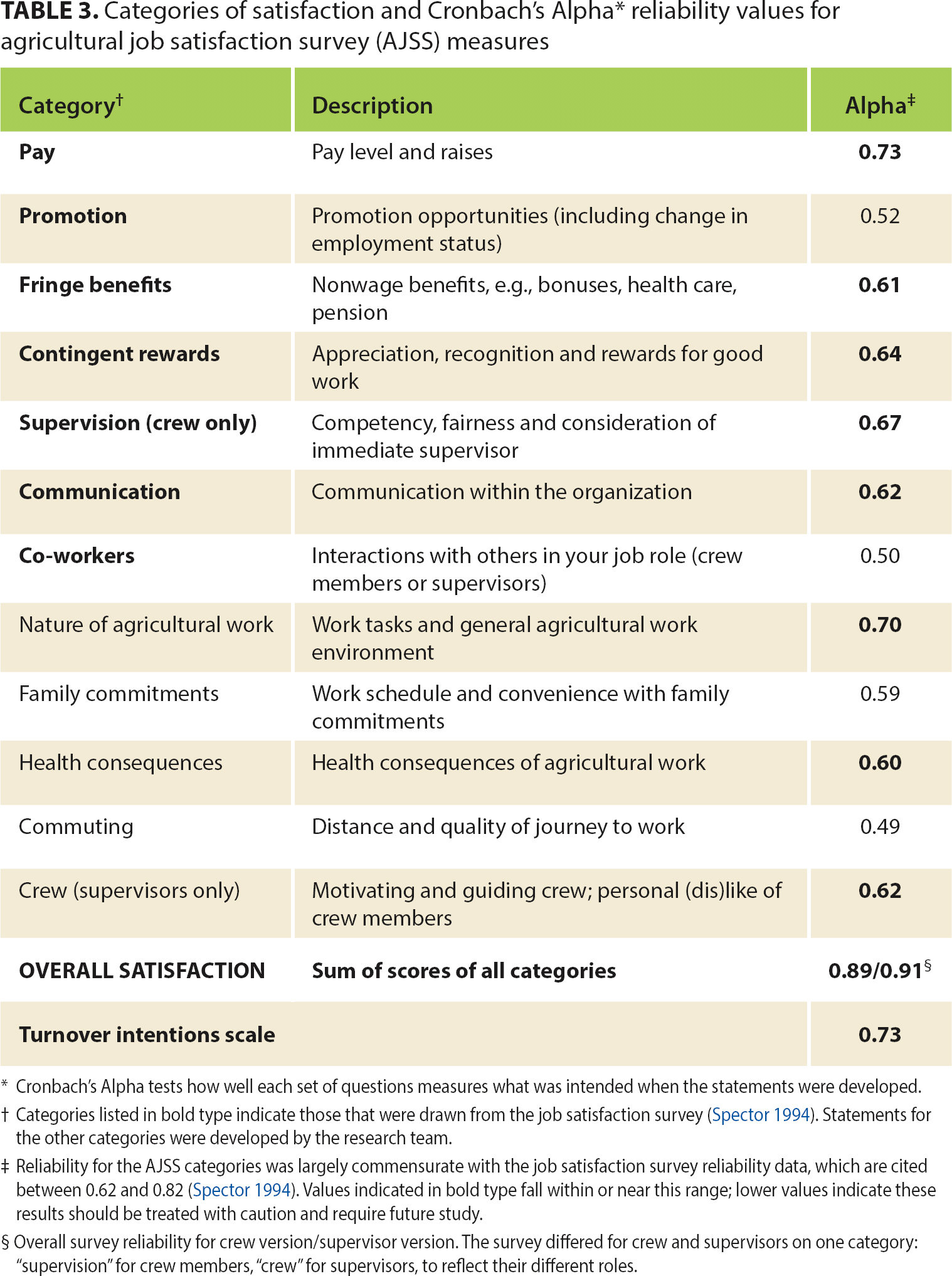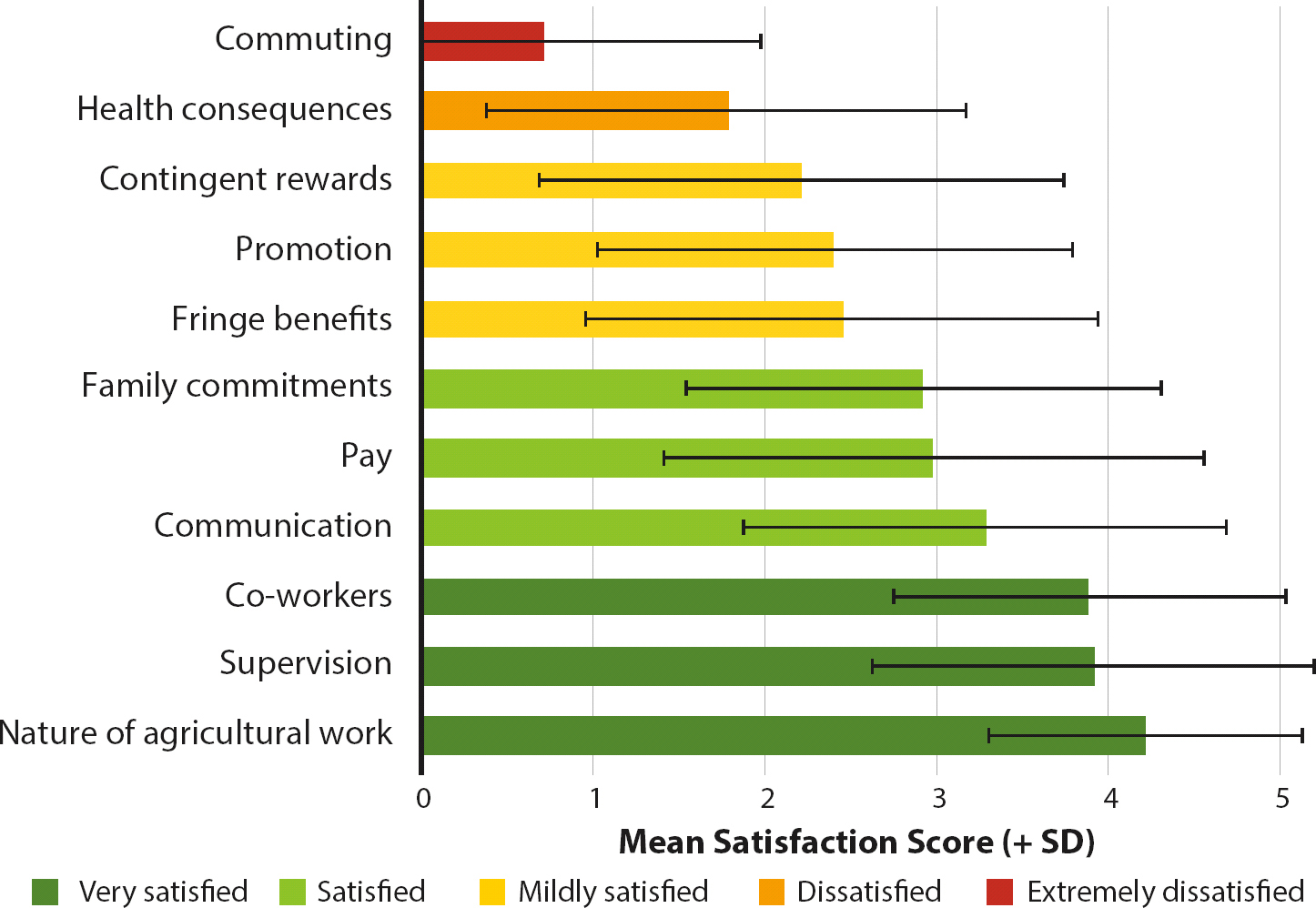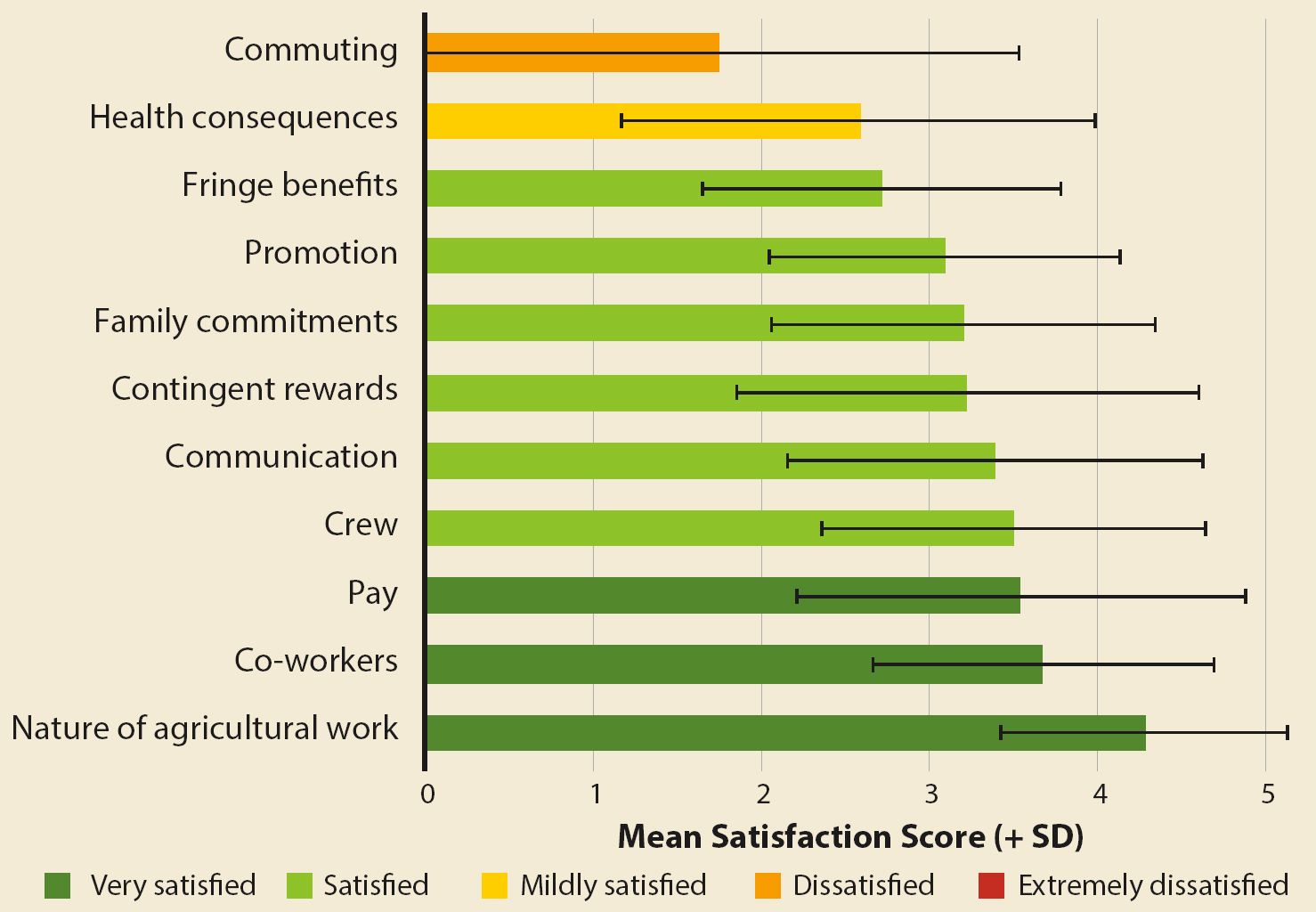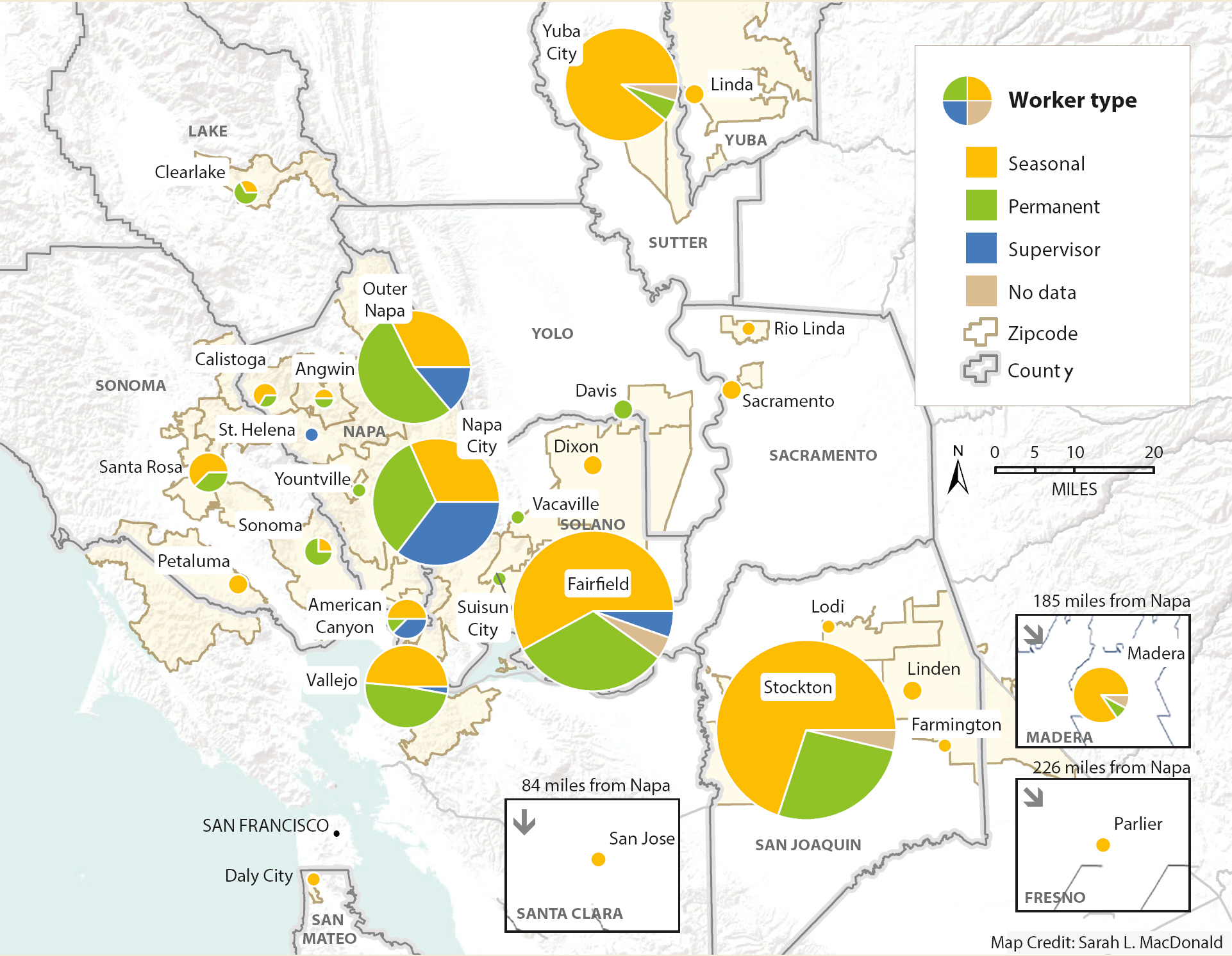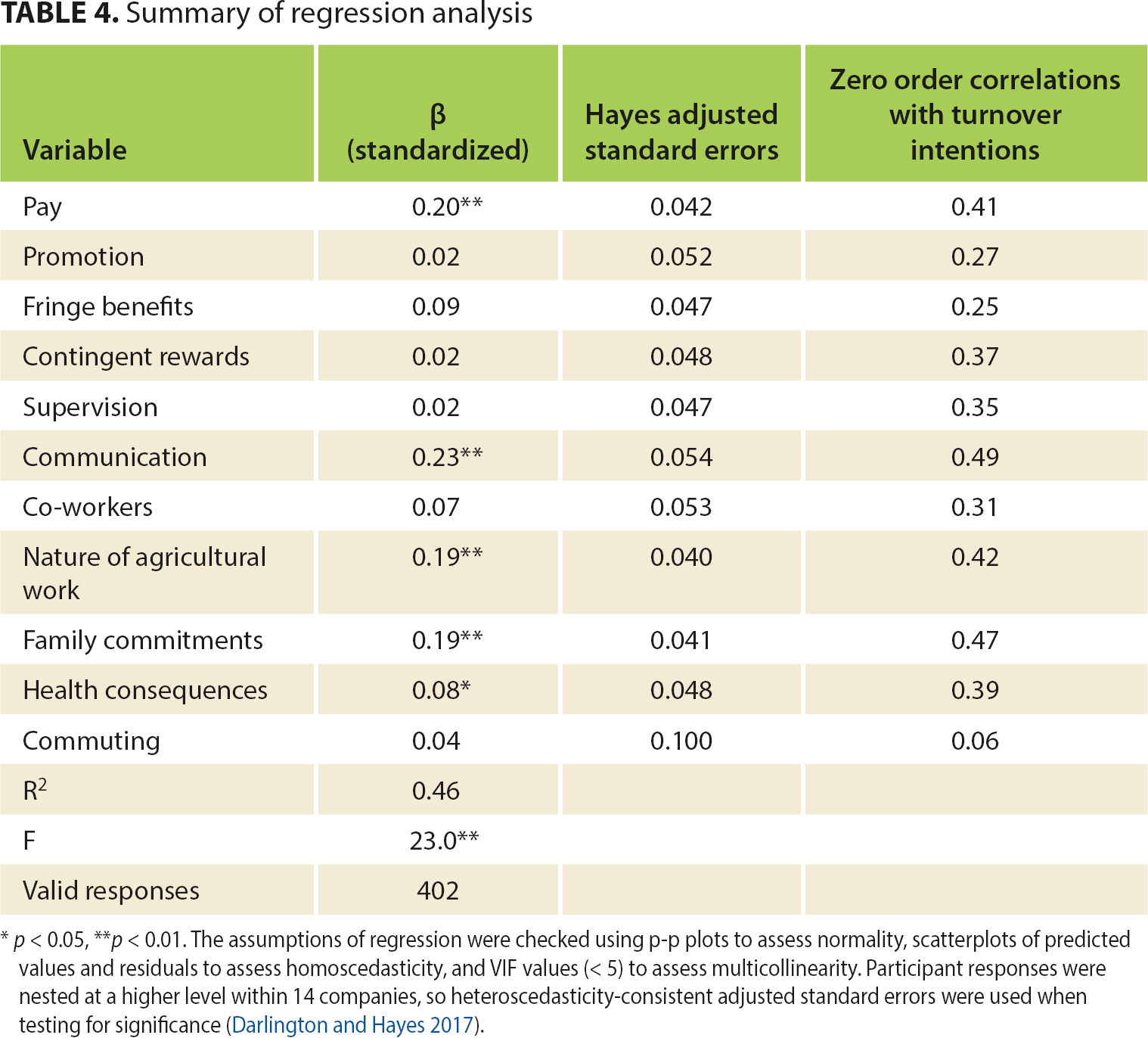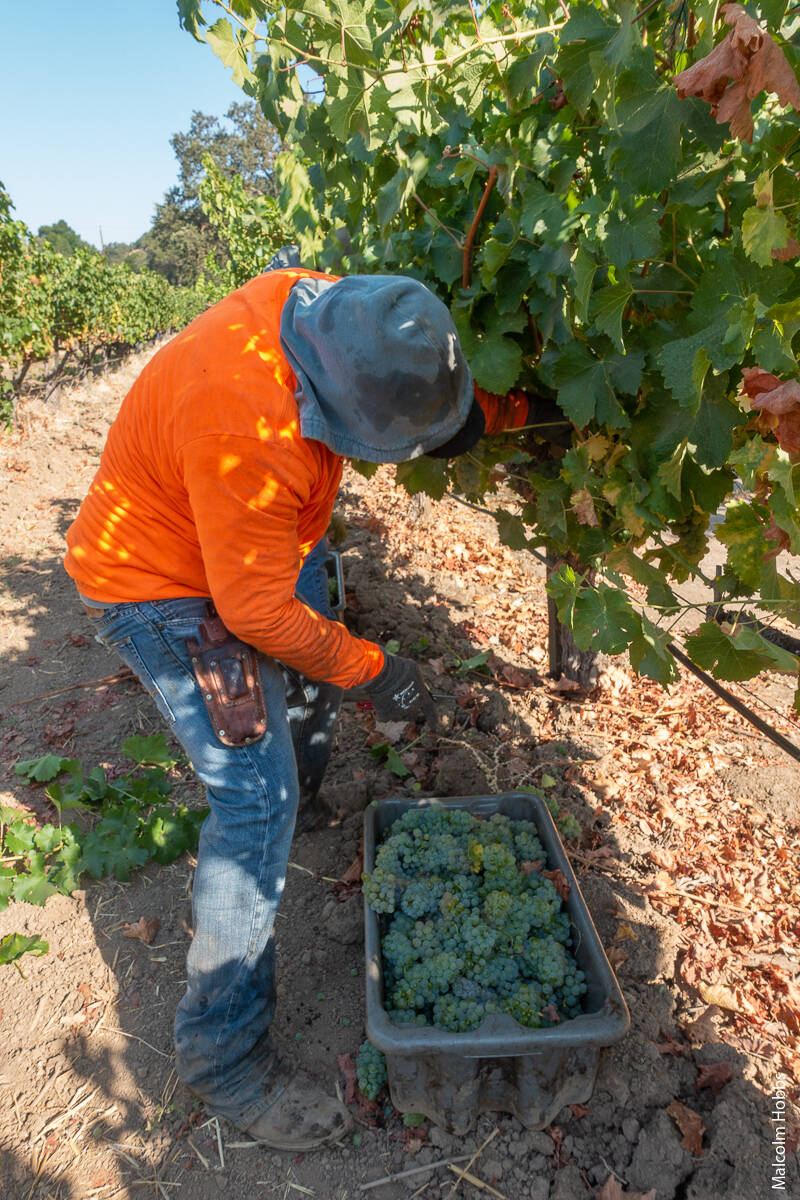All Issues
Job satisfaction assessments of agricultural workers help employers improve the work environment and reduce turnover
Publication Information
California Agriculture 74(1):30-39. https://doi.org/10.3733/ca.2020a0002
Published online March 17, 2020
PDF | Citation | Permissions
NALT Keywords
Abstract
Addressing the current labor shortage in California agriculture will require a multi-pronged approach, one of which may be increasing retention of current workers through improved job satisfaction. We developed a questionnaire to evaluate the job satisfaction of agricultural workers in 11 categories, tested the reliability of the questionnaire, and its relationship with worker turnover, in a sample of 665 vineyard workers. In our study, four sources of job satisfaction predicted turnover among Napa vineyard workers: communication, pay, nature of agricultural work, and family commitments. Improving these areas may increase job satisfaction and retention of existing workers to stabilize the agricultural workforce.
Full text
California has been faced with a shortage of farm labor in recent years (Charlton and Taylor 2013; Gonzalez-Barrera 2015; Martin 2018), primarily attributed to a decline in the number of Mexican migrant workers coming to the United States, who compose the majority of the labor force. Compounding the decline from abroad, migration within the United States has also dropped as farm labor has undergone a demographic transition: workers are more likely to be older, female and living with children (Fan et al. 2015). Labor shortages appear to have especially affected support activities, such as labor contractors (Hertz and Zahniser 2013). For example, the Napa County vineyard industry experienced an estimated 12% shortage of laborers in 2017 (Peri 2018).
Results from a survey of 611 Napa County vineyard workers indicate that workers were very satisfied with the nature of agricultural work, but dissatisfied with their commute and the health consequences of working in vineyards.
The agricultural industry is responding to this labor shortage in three ways (Martin 2018). First, growers are increasingly relying on machines to stretch worker productivity or as a substitute for hand labor (Downing 2018). Second, they are seeking to replace lost workers with a new labor source — for example, women (Hobbs and Cooper 2017) and H2-A guest workers, although the complications of providing housing in coastal California have limited the viability of the H2-A guest workers option. The third way is the focus of this study: offsetting the labor shortage by boosting retention of existing workers through increased job satisfaction.
High job satisfaction, defined as a “pleasurable or positive emotional state resulting from one's … job experience” (Locke 1976), is linked to positive effects on both employees and organizations, with evidence of a causal relationship (Erdogan et al. 2012). Benefits include lower worker turnover (Griffeth et al. 2000; Lambert et al. 2001; Tnay et al. 2013), increased work performance (Judge et al. 2001), lower absenteeism (Wegge et al. 2007) and healthier workers (Faragher et al. 2005).
Job satisfaction has been categorized in numerous ways, but core categories include the type of work performed, (financial) rewards, professional growth or promotional opportunities, supervision, and co-workers (Wood et al. 2011). Additional categories may be included under specific circumstances (e.g., difficulty of commute), and the most salient categories often differ between occupations (Singh and Loncar 2010).
Conversations on how to address satisfaction in the agricultural workplace understandably tend to focus on pay and benefits, with some acknowledgment that reducing harassment and favoritism is also beneficial (Martin 2018). Because the nature of the relationship between job satisfaction and turnover goes beyond financial compensation, companies may seek to reduce turnover by adopting strategies that carry a lower financial burden. This includes respectful treatment of workers, ensuring a safe workplace, providing workers a diversity of tasks and promotional opportunities, and formalizing labor relations procedures (e.g., grievance processes, formal orientations) (Strochlic and Hammerschlag 2006).
Despite decades of research on job satisfaction in other occupations (Martin et al. 2011), there has been a paucity of research on agricultural workers. To date, the few studies of satisfaction in California agriculture have been primarily based on interviews of workers (e.g., Billikopf 1999; Strochlic and Hammerschlag 2006). Building on this qualitative work, we developed a quantitative survey to identify and describe the job satisfaction categories that drive turnover in a population of Napa County vineyard workers. We investigated how satisfaction may vary by three key demographics — employment status (seasonal vs. permanent), gender and age. And we conducted a limited set of follow-up interviews with a selection of participating workers to explore specific issues raised in the survey.
Collectively, these results provide feedback to agricultural employers from their workers on how their company is performing in various aspects of job satisfaction, which strategies and activities they should invest in to boost job satisfaction, and how they can adapt their strategies to target specific worker demographics. We envision the agricultural industry adopting this survey tool to formally evaluate their progress toward improved job satisfaction and increased workforce sustainability.
Surveying vineyard workers
In summer 2018, we surveyed 611 vineyard crew members and 54 of their immediate supervisors from 14 companies operating out of Napa County (table 1). There were an estimated 10,000 vineyard workers in Napa County in 2018, and our survey therefore captured approximately 6.5% of the workforce. Participating employers learned about the study through contact with or recruitment by the UC Cooperative Extension research team or by advertisement at industry meetings. Under previous arrangements with their employer, survey participants completed the questionnaire in small groups (typically < 25) while at work and were paid their normal hourly rate while they participated.
TABLE 1. Demographics of sample population who participated in the Napa vineyard workers survey, 2018
Since all participants were Spanish speaking, the study was conducted in Spanish by a bilingual research assistant who displayed the questions on a flipchart and also read them aloud in Spanish. Participants were encouraged to signal when they did not fully understand a questionnaire item, whereupon the research assistant provided additional explanation. Responses were collected using electronic devices (Turning Technologies, Youngstown, OH), which allowed participants to respond anonymously. We also conducted semistructured follow-up interviews in Spanish to gather specific details from workers about a subset of the job satisfaction categories. Interview transcripts were translated into English and the conversations sorted into key themes (table 2), which we used to illustrate our conclusions. Twenty-two permanent workers (18 laborers, two tractor drivers, two irrigators; 16 were female) at three companies participated in the interviews. The survey questionnaire was composed of items from multiple tools as outlined below.
Demographics
Key demographic variables were recorded from each worker: age, gender, employment status (seasonal or permanent) and zipcode of residence. Employers provided details on the pay and benefits workers received.
Job satisfaction
A modified and expanded version of the job satisfaction survey (JSS; Spector 1994), a general tool broadly applicable to most occupations, was employed. The JSS requires participants to rate their agreement on a 0–5 scale (“completely disagree” to “completely agree”) for a series of statements relating to several categories of job satisfaction. We modified and expanded the JSS by adding our own statements pertaining to salient issues for California agricultural workers and Napa vineyards. Using factor analysis, we derived a final set of 45 statements (from an original 60), relating to 11 categories of job satisfaction (table 3). We refer to this final version as the agricultural job satisfaction survey (AJSS). From it, we derived numerical scores for each satisfaction category and an overall score for job satisfaction.
TABLE 3. Categories of satisfaction and Cronbach's Alpha∗ reliability values for agricultural job satisfaction survey (AJSS) measures
Turnover
We measured turnover using a turnover intentions scale (Abbas et al. 2012), a known antecedent of actual turnover (Wood et al. 2011). This is a three-item tool that quantifies the thoughts and plans an employee has about quitting a job.
Worker satisfaction varied across categories
Participating workers were “very satisfied” or “satisfied” with six of the measured categories and “mildly dissatisfied” to “extremely dissatisfied” with five categories (fig. 1), albeit with variation between individuals as indicated by the standard deviations. Workers were “very satisfied” with the nature of agricultural work, their supervisors and co-workers. Satisfaction levels were relatively high for internal communication, pay and family commitments. Workers were “extremely dissatisfied” with their commute to work and “dissatisfied” with the health consequences of vineyard work (see sidebars, pages 34 and 37). They were “mildly dissatisfied” with the fringe benefits offered, promotional opportunities and contingent rewards.
FIG. 1. Mean (+ SD) job satisfaction scores for 611 crew members who participated in the 2018 survey.
Seasonal and permanent workers, and male and female workers, did not differ (ps > 0.05) on overall satisfaction scores. However, seasonal workers were significantly more dissatisfied with the nature of agricultural work (p < 0.00), and men more dissatisfied with supervision (p < 0.00). We also found that the age of workers was positively correlated with the nature of agricultural work (r = 0.16), health consequences (r = 0.12) and promotion (r = 0.10).
Supervisors have higher job satisfaction
We analyzed the data for the 54 supervisors separately. Terminology differs among employers, but most participants were crew leaders — that is, they were responsible for supervising a single crew. A few participants (typically in the smaller companies) also fulfilled higher supervisory roles, under the title field supervisor.
Overall, supervisors had greater job satisfaction than the workers they managed, expressing dissatisfaction on average with just two categories: commuting and health consequences (fig. 2). Despite expressing dissatisfaction with commuting, the average commuting score was considerably higher than laborers’ commuting score (and with widespread variation), reflecting supervisors’ closer proximity to their place of work (see sidebar, page 35). As with laborers, the supervisors were “very satisfied” with the nature of agricultural work and co-workers. Supervisors were also “very satisfied” with their pay, which ranged between $19.00 and $29.00 per hour when they were strictly crew leaders, and up to $34.00 when they also fulfilled other supervisory duties.
FIG. 2. Mean (+ SD) job satisfaction scores for 54 supervisors/crew leaders who participated in the 2018 study.
As with the crew members, overall job satisfaction was negatively correlated with turnover intentions (r = 0.65), illustrating the importance of job satisfaction for retaining supervisory-level employees. The lower sample size precluded regression analysis, but we did note that correlations with turnover intentions were strongest between family commitments (r = 0.69) and communication (r = 0.54), suggesting that supervisor turnover may be driven by issues similar to the ones affecting crew member turnover.
Commuting: Where do Napa workers live?
Supervisors tended to reside in or close to Napa, within a radius of 20 to 30 miles, with the farthest living in Fairfield (fig. 3). Of the permanent workers, 35% lived in Napa County, with the remainder primarily commuting from Solano (30%; 15 to 30 miles) and smaller proportions living in San Joaquin, Sonoma, Yuba and Lake counties. A small number of seasonal workers (14%) lived in Napa, but most commuted from Solano (23%) and San Joaquin (30%) counties, with a significant number travelling extraordinary distances, to a radius of 226 miles: notably Yuba City (100 miles), Madera (185 miles), and Parlier (226 miles). Thus, the majority of permanent and seasonal laborers in this sample faced long and exhausting commutes from outside Napa County, reflected in the “extremely dissatisfied” rating for commuting (fig. 1; table 2). Travel times even for workers closest to Napa (e.g., Vallejo, Fairfield) can be lengthy at busy times of the day on roads that are frequently gridlocked with traffic.
FIG. 3. Zipcodes of residence for Napa County vineyard workers. Permanent and seasonal workers and supervisors provided their home zipcodes. Size of pie is representative of number of workers in that area, with the smallest pie (St. Helena) = 1 participant and the largest pie (Stockton) = 138 participants.
In Napa County, a chronic housing shortage has forced farmworkers to reside outside the county (Strochlic et al. 2007). Supervisors and permanent workers earning a higher wage can more easily live near their place of work, but there is insufficient affordable accommodation for the seasonal labor force. Online real estate searches (e.g., rentjungle.com ) show that in the time period we conducted this study residential property rent in Napa averaged $2,500 per month, compared to $1,800 in Fairfield, $1,100 in Stockton and $700 in Yuba City.
The inability to house sufficient workers in Napa has produced higher wages than in surrounding counties (FELS 2010; Martin et al. 2018), as companies must attract workers from farther afield. Our data indicate that this approach is broadly successful, if not a complete solution: pay was a predictor of turnover, but commuting was not. Farmworkers come to work in Napa vineyards for higher pay despite punishing commutes. However, long commutes have negative impacts on safety (Milia et al. 2012), health (Stutzer and Frey 2008), work performance/productivity and relationships with other employees (Michie 2002) and family (Sandow 2010).
Housing problems can be addressed by government authorities and private industry. The best solution may be to build more affordable farmworker housing; although expensive in the short term, this may have long-term benefits, particularly if employers can no longer afford competitively high wages necessary to draw in workers. Napa County has three efficiently run farmworker housing centers for 180 workers (Eberling 2018), which may partially account for the populations of workers we found living in Napa. The county also offers rental assistance to low-income households (Watt 2010). Companies can also opt to provide housing for workers. This would help them take advantage of the H2-A program, although they may be unwilling to take on the cost and management burdens or to be as challenged as the government is to find sites for affordable housing.
Commute and housing issues can also be partially addressed by improving transport networks to make commutes more efficient and less stressful. Most workers travelled to work in their own cars or in private ride shares. Unfortunately, shared transport, vanpool programs (Strochlic 2009) and public transit are likely to face resistance from workers, who, although generally supportive, were blunt about preferring their own transport. Company-owned vans are also costly, and many managers would prefer to know workers will use them before justifying such investment.
Despite spending large portions of their wages on gas (table 2), these workers valued the flexibility of their own vehicle, so fuel allowances for workers may be the lowest-cost option for companies to help workers. Workers in this study employed by management companies did also suggest a low-cost strategy could be to rotate crews to different vineyards to shorten their commutes for at least part of the season, although this is only an option for a company that works in multiple vineyard sites.
Four categories predicted turnover
Overall job satisfaction had a moderate negative correlation (r = 0.59) with turnover intentions, indicating that dissatisfaction was associated with an increased intent to quit a company. We used regression to explore the specific satisfaction categories that predicted turnover intentions, with age, gender and employment status as control variables, and the 11 satisfaction categories as predictors of the turnover intentions measure.
Four satisfaction categories significantly predicted turnover intentions, with a negative relationship in each case, and explained 46% of the variance in turnover intentions (table 4). Communication had the greatest influence (0.23), closely followed by pay (0.20), family commitments (0.19) and nature of agricultural work (0.19). The remaining categories did not significantly predict turnover intentions, although fringe benefits (p = 0.08) and health consequences (p = 0.09) were close to significance.
This study accounted for 46% of the variance of turnover intentions, leaving 64% unaccounted for by variables we did not measure. These could include reunification with family from home country (Gonzalez-Barrera 2015), workplace sexual harassment (Hobbs et al., unpublished data; Prado et al. 2018) and employment security (Strochlic and Hammerschlag 2006). Although we attempted to measure the latter, our statements failed as a reliable measure and we ejected them from the results. However, we acknowledge the importance of addressing other potential factors in future studies.
Health consequences: What health-related issues are workers concerned about?
Health consequences was the second lowest ranking satisfaction category and has been found to be important in other studies (Nather et al. 2015). Agricultural workers face numerous workplace health risks including heat illness (Stoecklin-Marios et al. 2013), pesticide exposure (Flocks et al. 2011), musculoskeletal problems (Osborne et al. 2012) and workplace accidents (McCurdy and Carroll 2000). Tackling such issues contributes to a healthier, more productive and sustainable workforce.
The permanent vineyard workers interviewed in this study (table 2) indicated they were satisfied with general health and safety practices of their employers, but some wanted greater provision of basic equipment (e.g., boots, gloves). There was also widespread concern about pesticide exposure and risk of chemical drift from neighboring vineyards. Given the substantial public investment in worker protection, future studies should further explore the risk, worker perceptions and possible synergies with improved communication around worker health and safety.
Employers can demonstrate a high regard for worker safety using low-cost methods such as providing essential equipment and effective health and safety education, training, equipment and protocols. They can also limit time spent on repetitive tasks where injuries are likely and ensure prompt medical attention in the case of serious injuries (Strochlic and Hammerschlag 2006). Higher-cost strategies include time off to recover from injuries or accidents followed by “light duty” (Strochlic and Hammerschlag 2006) and company-subsidized health coverage for workers.
Strategies to boost worker retention
In our study population, vineyard worker turnover was explained by four categories of job satisfaction. Although this regression analysis cannot determine causation, our results suggest that Napa vineyard companies can best boost worker retention and alleviate labor shortages by focusing resources on strategies to improve these aspects of the work environment. It should also be evident that, although important, raising pay is not the only avenue to address worker retention and that employers can be proactive in implementing low-cost strategies to reduce turnover with limited resources. Additionally, employers who are already offering competitive pay rates can address worker retention using the other strategies. The interviews (table 2) and Strochlic and Hammerschlag (2006) provided further detail on these strategies.
Effective communication (low-cost strategy)
The importance of communication likely lies in its ability to signal respectful treatment, and, when it's poor, to exacerbate other problems, making them hard to resolve. Respectful treatment is very important for workers who have been abused and exploited on farms (Strochlic and Hammerschlag 2006). Strategies to improve communication include respectful communication styles (e.g., “no yell” policies), direct grower-worker communication channels, decision-making structures that recognize the contribution of individual workers, training of supervisors, and specific company policies as to how workers should be treated.
The workers we interviewed did not raise many concerns about being disrespected, but some expressed concern about grievance procedures for reporting supervisors, gave mixed reports on the quality of communication and repeatedly claimed they did not feel well informed about some topics (e.g., pending changes to pay, why another worker got promoted over them). Companies should prioritize improving internal communication, given its role as the best predictor of turnover, and the strategies noted here are of very low cost in comparison with strategies for the second most important predictor of worker turnover: pay.
Improve pay (high-cost strategy)
Workers in Napa were generally happy with their pay rates, but responses varied considerably among workers. All workers in the sample received hourly pay (rather than piece rate), which ranged from $15.50 to more than $20.00. Satisfaction depended in part on whether a worker perceived their wage to be commensurate with what competitors were offering. A primary strategy to stabilize worker retention is to match average regional wages. Tracking changes in average wages can be difficult, especially currently, as new regulations are being phased in (Isom 2019). However, regional organizations and collaborations can generate comparisons and advice on setting appropriate wage levels.
Worker retention may also be improved by paying wages higher than the regional average to draw in workers from farther away. This tactic has been used in Napa County, which has the advantage of an industry that can support higher wages — at least over the short term. It has been somewhat useful in offsetting worker housing shortages (see sidebar, page 35); however, it can result in health consequences to the employee related to longer commute times. Above-average wages are a high cost to an employer, but lower-cost pay-related strategies are available. For example, as we learned during the interviews, structured pay scales that fairly reflect experience, seniority and company loyalty are important to workers. Pay rates that did not reflect company tenure/experience were unpopular, as were pay scales that delivered meager increases for seniority.
Help workers fulfill family commitments (medium-cost strategy)
Long work hours, unconventional work schedules that vary seasonally and frequently entail early start times, and the often insecure nature of agricultural employment make it challenging for workers to honor family commitments. Additionally, the agricultural workforce has become increasingly populated by individuals with greater family commitments (Fan et al. 2015). Agricultural work is typically more demanding in summer and less demanding in winter, but family commitments may be greater in summer months, when school is not in session, creating a conflict with agricultural work.
Also, seasonal workers in our study tended to commute greater distances than permanent workers (see sidebar, page 35). This is a challenge for seasonal workers not only because of the added travel time but working far from home can make it difficult to leave work in the middle of the day for family commitments or appointments. Additionally, seasonal workers tended to carpool, and the lack of a personal vehicle complicates the logistics of fulfilling family commitments.
Potential strategies include offering a reasonable number of vacation days for workers to rest and take care of family business, logistical flexibility where possible, a degree of personal freedom at work to take care of personal needs, and child care subsidies or the support of local initiatives for child care provision.
Consider nature of work (low-cost strategy)
The types of tasks performed and the general vineyard work environment (e.g., working outside) were an important influence on turnover. Our study population was “very satisfied” with the nature of agricultural work, as has been reported in other California regions (Billikopf 1999), suggesting that workers who lack an affinity for agricultural work are weeded out quickly, leaving those who feel more positive about the work environment.
In our study, seasonal workers reported greater dissatisfaction than permanent workers. Seasonal work is the entry position into agricultural labor, and workers new to the vineyard environment may take time to adjust. Lacking experience, they may also have less responsibility and variety in tasks to perform. Although this category is largely beyond the control of a company, providing a greater diversity of tasks for workers could address some concerns (Strochlic and Hammerschlag 2006). Workers also appreciated a humane pace of work (table 2). This could be an especially important strategy for retaining older workers, who feel pressured by companies demanding strict time-based outputs.
Overall, seasonal workers who responded to the survey reported greater dissatisfaction with their jobs than permanent workers.
Expanding job satisfaction surveys to other agricultural regions and commodities
The sample in this study was restricted to vineyard workers in Napa County. Although the levels of job satisfaction (fig. 1) are specific for this population and cannot be generalized to other agricultural worker populations, the AJSS could be utilized in other regions to assess local conditions and develop remediation strategies. The four categories of satisfaction that predicted turnover in Napa vineyard workers may be important in other regions and agricultural industries. For example, crop and dairy workers ranked fair pay and family issues as the top reasons for seeking other employment (Billikopf 1984, 1999), and communication was the attribute workers most valued in their supervisors (Billikopf 1999).
There are also indications that some of the categories important for turnover might extend to employees in supervisory jobs (see sidebar, page 34). However, replicated studies in other regions with workers of different demographic circumstances are required to fully determine how far these results can be generalized. The original survey (JSS), of which the AJSS is a modified form, is a general tool designed to be used across occupations, and the AJSS retains this broad approach. In summary, the AJSS is a tool to study any population of workers within the agricultural industry to understand their job satisfaction and to develop strategies to promote job satisfaction.
Employers can be proactive
Our work highlights that agricultural employers can be proactive in retaining employees to offset labor shortages using cost-efficient methods. Although it is critical to offer wages commensurate with the regional average, a combination of improvements in communication, diversity of work tasks and consideration for family commitments can influence turnover to a greater degree than further increases in pay alone.
We captured a snapshot of vineyard worker satisfaction in 2018; some employers had already adopted strategies to improve job satisfaction and some had not, which may account for some of the variability in the levels of satisfaction among workers. Future studies may seek to evaluate which strategies are most effective by assessing changes in worker perceptions before and after the introduction of new practices, using tools such as the AJSS.
The authors suggest that companies can increase worker retention by adopting strategies to improve communication and pay, help workers fulfill family commitments, and provide a greater diversity of tasks.
In addition to reducing turnover, improving job satisfaction can also increase work performance and worker health outcomes. Therefore, the satisfaction categories that did not predict turnover should not be dismissed, as dissatisfaction in these areas can contribute to other negative consequences.
The AJSS tool overall proved reliable, but it contains four categories with low reliability (< 0.60, table 3) that require further adjustment and retesting in future studies. In the long term, we are confident that adoption of this tool by the industry could support improvements in productivity, worker health and happiness, and promote the sustainability of the agricultural workforce.



